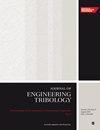Progress in polymeric and metallic brake pads: A comprehensive review
IF 1.8
3区 工程技术
Q3 ENGINEERING, MECHANICAL
Proceedings of the Institution of Mechanical Engineers, Part J: Journal of Engineering Tribology
Pub Date : 2023-10-06
DOI:10.1177/13506501231204655
引用次数: 0
Abstract
The use of asbestos in brake pads is being eliminated due to its carcinogenic effect. Due to this, there is a need for better alternative in the brake pad material to replace asbestos fibers. This leads to the development of more natural fibers/filler-based brake pads which are safer to the environment, cheaper, and readily available. Moreover, bio fillers-based brake pads have shown excellent performance compared to asbestos. This paper addresses the different composition of brake pad materials and manufacturing techniques. Common binders like epoxy resin, Phenolic resin-based brake pads were analyzed and its effect on the mechanical, tribological, and thermal performance were critically analyzed. Also, the performance of metal matrix-based brake pad has been analyzed in detail. It has been observed that utilizing natural fibers as a reinforcement provides an excellent braking performance compared to metallic and carbon fiber-based brake pads. This research will open new avenues towards “Net Zero.”聚合物和金属刹车片的研究进展综述
由于石棉的致癌作用,在刹车片中的使用正在被淘汰。因此,需要更好的替代刹车片材料来代替石棉纤维。这导致了更多的天然纤维/填料为基础的刹车片的发展,更安全的环境,更便宜,更容易获得。此外,与石棉相比,基于生物填料的刹车片表现出优异的性能。本文论述了刹车片材料的不同组成和制造工艺。分析了环氧树脂、酚醛树脂等常用粘结剂对刹车片力学性能、摩擦学性能和热性能的影响。并对金属基刹车片的性能进行了详细的分析。据观察,利用天然纤维作为强化材料,与金属和碳纤维为基础的刹车片相比,具有优异的制动性能。这项研究将为实现“净零”开辟新的途径。
本文章由计算机程序翻译,如有差异,请以英文原文为准。
求助全文
约1分钟内获得全文
求助全文
来源期刊

CiteScore
4.20
自引率
5.00%
发文量
110
审稿时长
6.1 months
期刊介绍:
The Journal of Engineering Tribology publishes high-quality, peer-reviewed papers from academia and industry worldwide on the engineering science associated with tribology and its applications.
"I am proud to say that I have been part of the tribology research community for almost 20 years. That community has always seemed to me to be highly active, progressive, and closely knit. The conferences are well attended and are characterised by a warmth and friendliness that transcends national boundaries. I see Part J as being an important part of that community, giving us an outlet to publish and promote our scholarly activities. I very much look forward to my term of office as editor of your Journal. I hope you will continue to submit papers, help out with reviewing, and most importantly to read and talk about the work you will find there." Professor Rob Dwyer-Joyce, Sheffield University, UK
This journal is a member of the Committee on Publication Ethics (COPE).
 求助内容:
求助内容: 应助结果提醒方式:
应助结果提醒方式:


